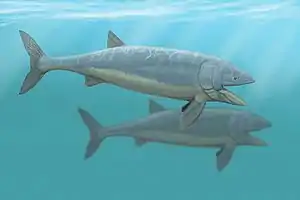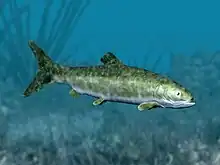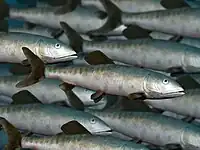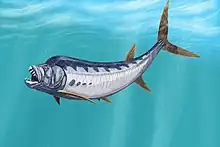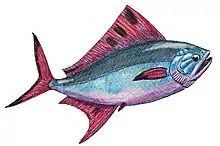Chuhsiungichthys
Chuhsiungichthys is an extinct genus of ichthyodectiform ray-finned fish that lived in freshwater environments in what is now Yunnan, China,[2] and Kyushu, Japan,[1] during the Cretaceous. It differs from its sister genus, Mesoclupea, primarily by having a comparatively more anteriorly-placed dorsal fin.
| Chuhsiungichthys Temporal range: | |
|---|---|
| Scientific classification | |
| Kingdom: | |
| Phylum: | |
| Class: | |
| Order: | |
| Family: | Yabumoto, 1994[1] |
| Genus: | Chuhsiungichthys Lew 1974 |
| Type species | |
| Chuhsiungichthys tsanglingensis Lew 1974 | |
| Species | |
| |
The type species, C. tsanglingensis, is found in Upper Cretaceous-aged strata of Chuhsiung, Yunnan Province. C. yanagidai is found in the first formation of the Lower Cretaceous-aged Wakino Subgroup, in Kyushu. C. japonicus is found in the fourth formation of the Wakino Subgroup.
References
- Yabumoto, Yoshitaka (March 30, 1994). "Early Cretaceous Freshwater Fish Fauna in Kyushu, Japan" (PDF). Bulletin of Kitakyushu Museum of Natural History. 13: 107–254 [130]. Archived from the original (PDF) on 2015-06-20.
- Lew, Chih-Ching (1974). "A NEW CRETACEOUS TELEOST FROM CHUHSIUNG, YUNNAN". Vertebrata PalAsiatica. 4 (3).
This article is issued from Wikipedia. The text is licensed under Creative Commons - Attribution - Sharealike. Additional terms may apply for the media files.
